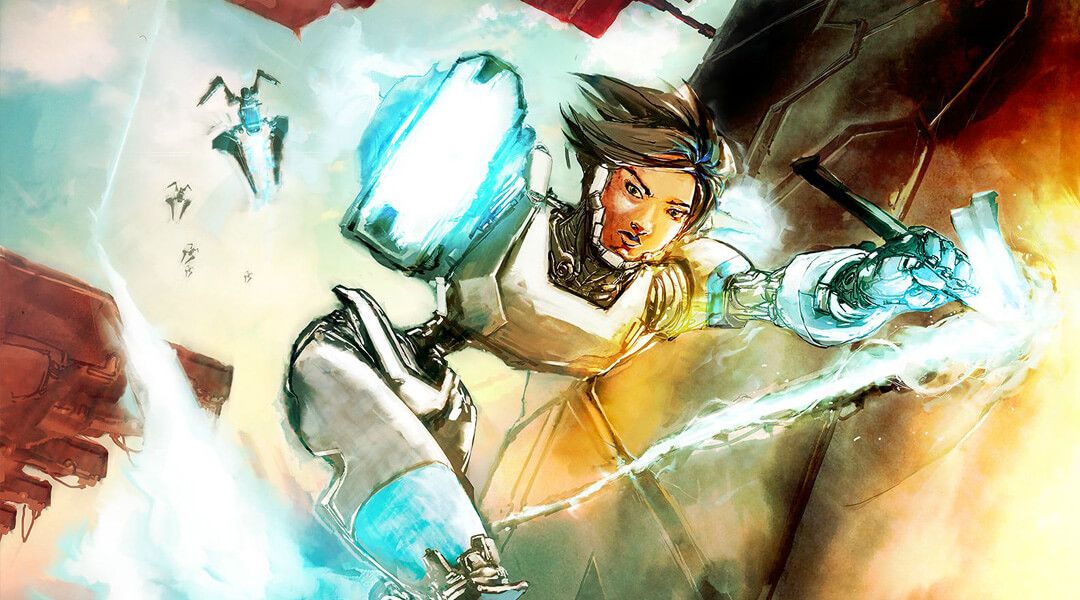Suppressive Fire Games releases Blood Alloy: Reborn after a failed Kickstarter campaign, but problems with basic gameplay elements severely hinder a title that had potential.
After a failed Kickstarter campaign in 2013, Suppressive Fire Games has pushed through with the development of what it hopes to be a hit, score attack title. In Blood Alloy: Reborn, players take on the role of a cyborg named Nia, who is able to action slide and double-hop her way across a limited selection of maps, gunning down and slashing robotic enemies as she navigates a simple 2D score-based title.
Unfortunately, Blood Alloy: Reborn brings nothing new to a market saturated with better 2D arcade style action games, and plenty of problems with basic gameplay elements are indicative that this title wasn't yet ready for release. When compared to other popular cyberpunk titles like Technobabylon and Satellite Reign, Blood Alloy simply falls far short of the mark.
The first thing players will see when booting up the game is the menu of Blood Alloy: Reborn, and it is a good representation of the rest of the game: it is unnecessarily frustrating to use, and one has to wonder how such a simple mechanic could turn sour. The menu inexplicably disables the mouse, which can only be used once the game begins. The menu also renders at lower resolutions, and the lack of a public leaderboard is an odd omission for a game where the only 'victory' one can accrue is getting a high score. Where's the fun in that, if one can't even compare their score with a friend's?
Once players get past a lackluster tutorial section that explains the controls (there's no real plot to the game - robots patrol the map, and the player fights them), players are thrown into the first of three levels that they must replay several times the second level will become available. As soon as players attempt to move, the game's biggest flaw rolls into light: the camera for the game is quite troublesome. The character moves so quickly and the camera pans so slowly that the player is almost never at the center of the screen.
In a game where enemies are quickly moving about, this means players will likely die simply because they couldn't see the hazards in front of them. Somewhat strangely, when players use their boost ability the camera will pan out and that view is perfect, but boosting only lasts a matter of seconds, and then the camera is back to something ill-adapted for this type of game.
Other basic elements of an arcade-style game are also missing: when the player takes damage, there's no indicator on the screen aside of the health bar itself, which depletes silently. Visual feedback is an integral part of any score attack game, and Blood Alloy: Reborn is lacking in this regard. The game does allow a few modifications to the player's arsenal, but these don't really 'stir the pot' of the gameplay, so to speak, and they fail to make the game stand out.
That said, there are moments in the game where playing is enjoyable. The camera isn't too far behind, the enemies are coming in, and the player is jumping around, sliding along walls, and blasting away a horde of flying robots. It's not hard to see the potential that was here. Then the moment is gone, the camera has fallen behind, and the player takes damages without realizing and the game is over.
In contrast to almost every single gameplay element we encountered, the setting and soundtrack are actually quite nice. The cyberpunk music fits the theme of the game to a T, and the upbeat rhythm brings a distinct arcade vibe that works well with the SNES-inspired graphics of Blood Alloy: Reborn. This doesn't come as too much of a surprise, as developer Suppressive Fire Games is comprised of former employees of Harmonix Music Systems (guest artists like Perturbator don't hurt, either). If the rest of the game had come as highly polished as the music and sprite animations, this would be an entirely different review - unfortunately, it's all downhill from there.
Once players finish a round, the game tallies the score and dolls out some bonus points for specific tasks. Unfortunately, it seems that the game is fond of awarding points for tasks that the player didn't even complete, and we constantly found ourselves getting points for things like '2 minutes without attacking' when we spent the entire round blasting away every few seconds. It's a lack of attention to details like this that exemplifies all that is wrong with Blood Alloy: Reborn.
Coming in at $12, Blood Alloy: Reborn doesn't warrant its affordable price tag. There's plenty of work left to be done on the game, and some rough patches that need smoothing over. The game does boast an enjoyable soundtrack, but little else.
Blood Alloy: Reborn is available now on PC, and is slated to release for Xbox One, PSN, and Wii U at a later date. Game Rant was provided a PC code for this review.

